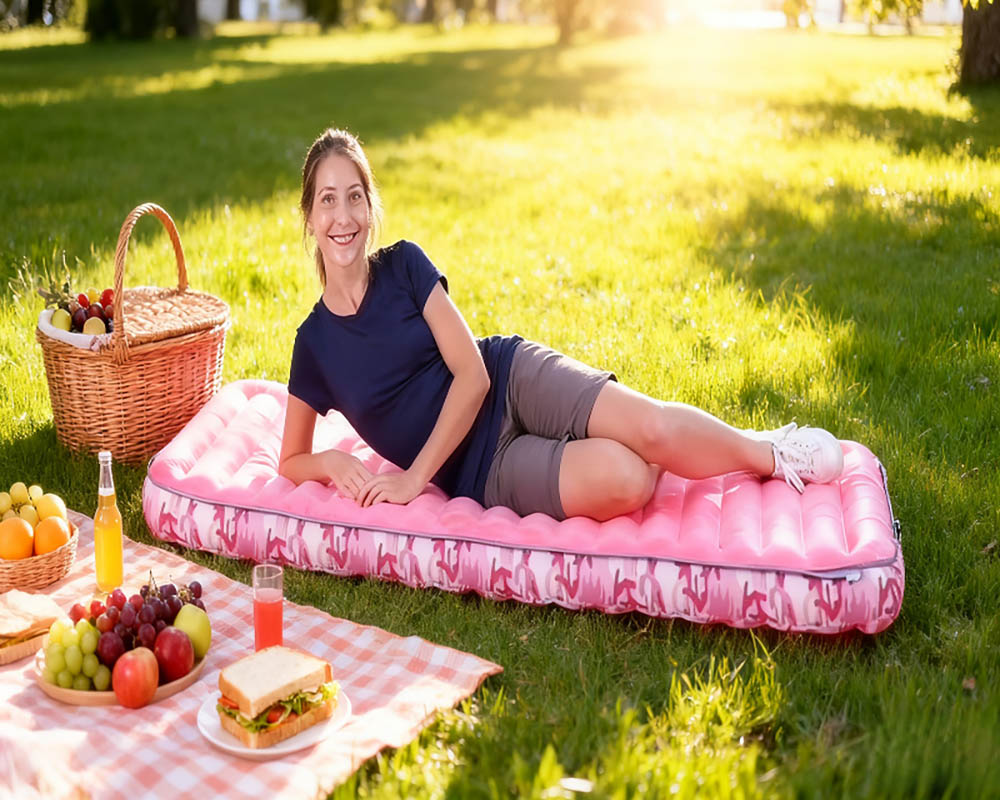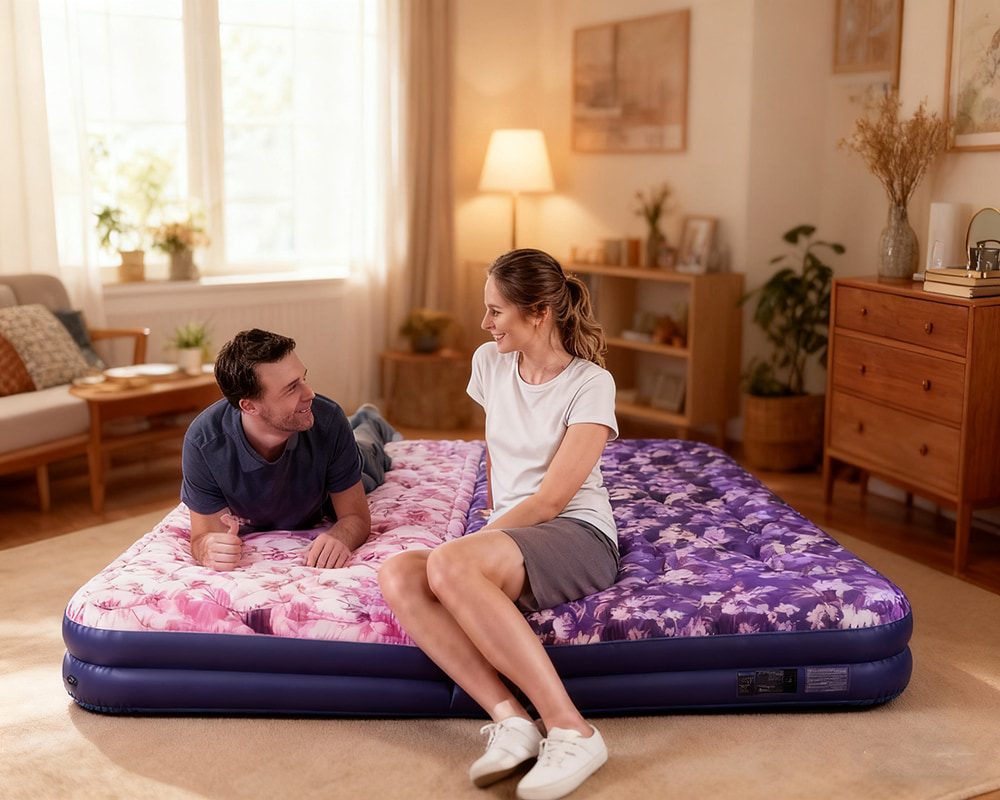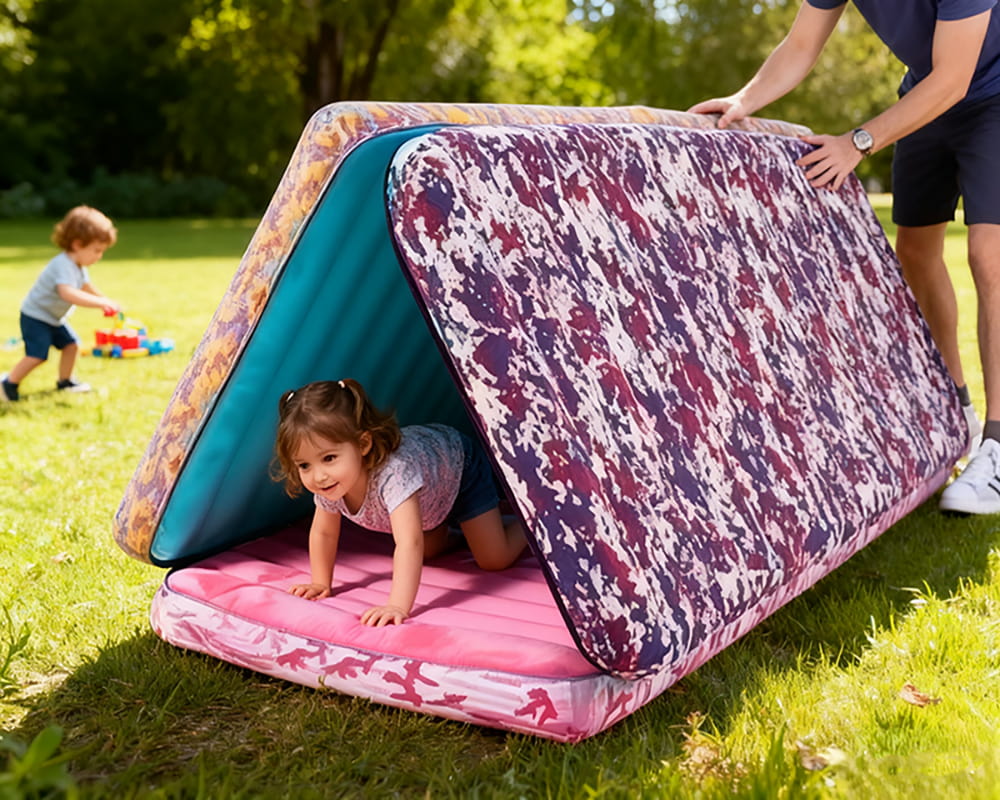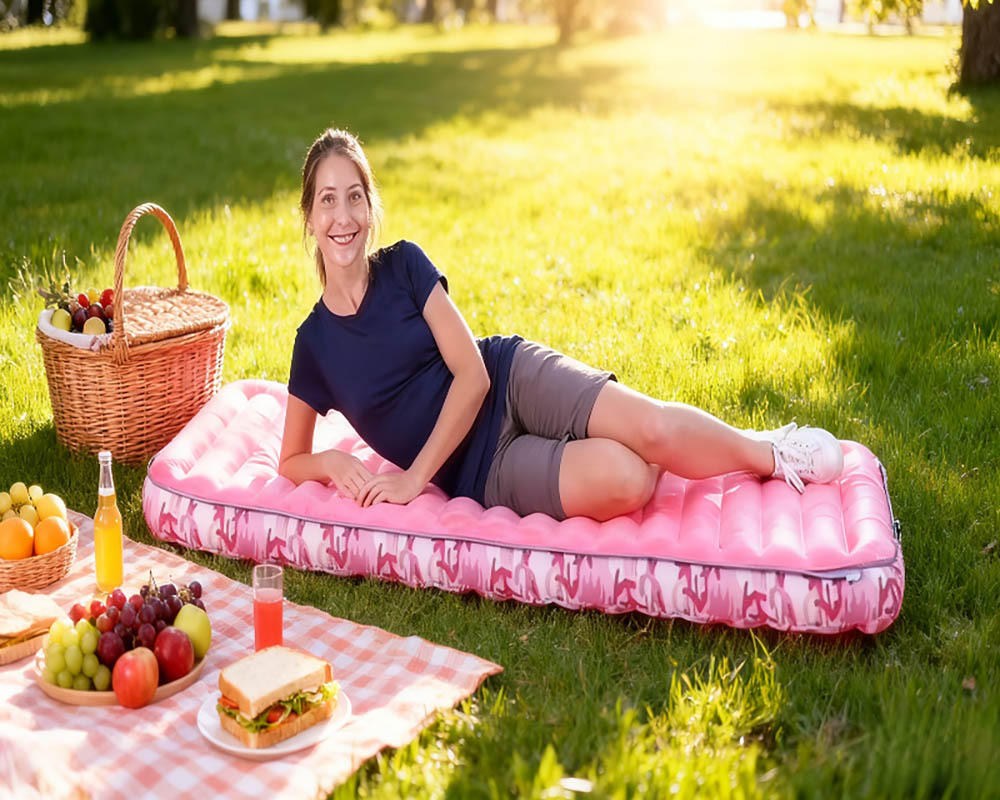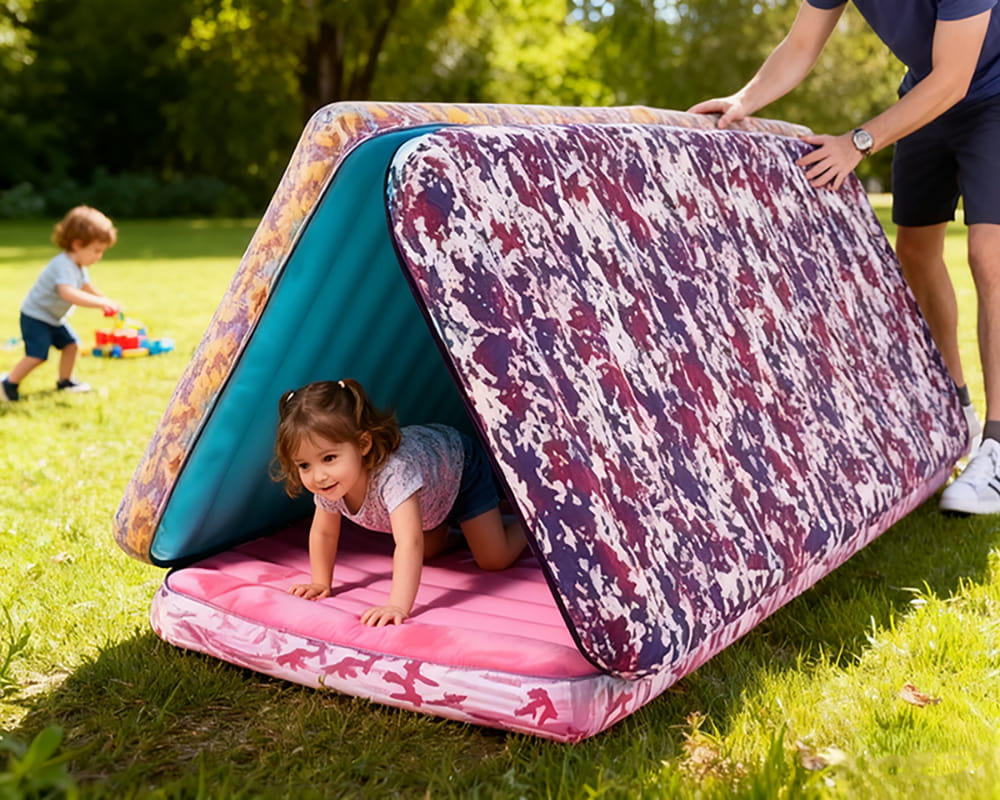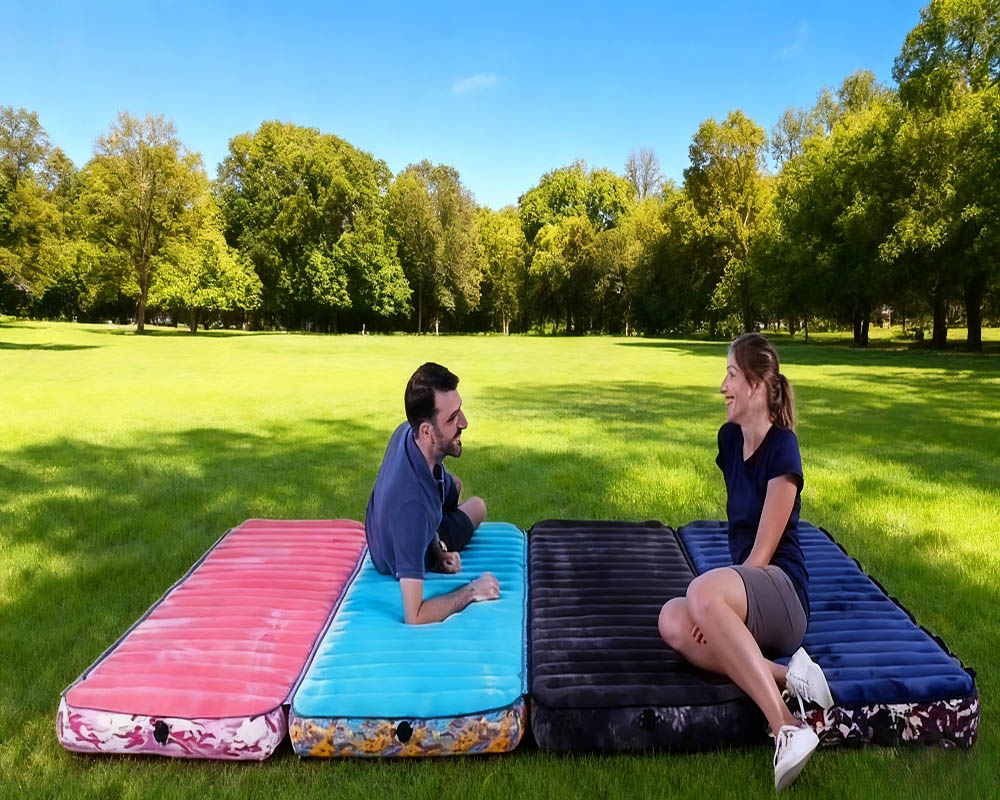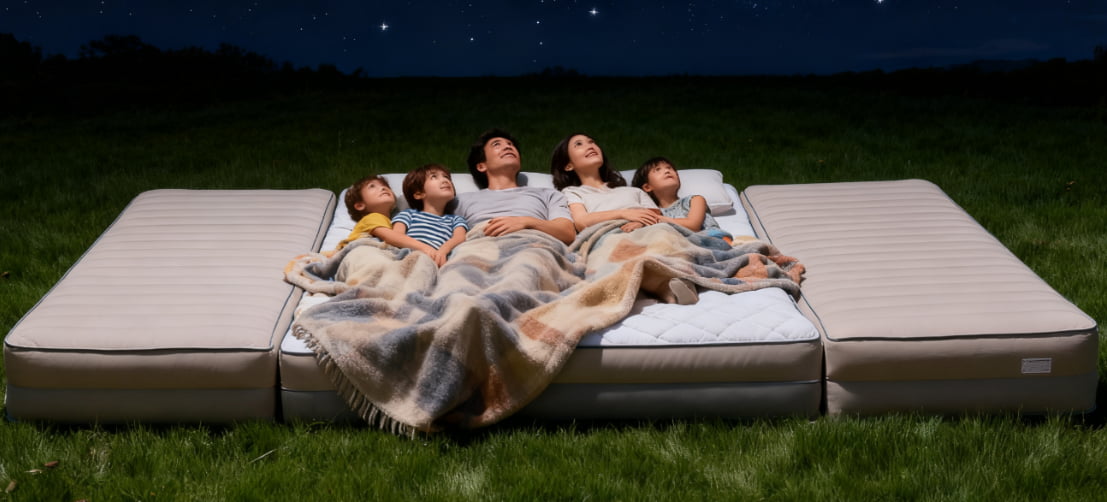
Who Should Choose Dreamate?
- Couples/Roommates Sharing a Space:Zoned Support Air Mattress resolves conflicts over preferred mattress firmness, allowing undisturbed sleep even when sharing a bed.
- Families with Pets/Kids: Features a detachable, machine-washable design that easily handles stains and mites.
- Renters/Small Apartment Dwellers: Foldable Air Mattress easy to store and lightweight, eliminating stress during moves or when storing the mattress.
- People with Lumbar Discomfort/Mixed Sleeping Positions:Smart Air Mattress with Remote Control 6 levels of firmness adjustment let you switch to spine-support mode anytime, ensuring comfort whether you sleep on your back or side.
Mattress Buying Guide to Avoid Pitfalls
- Prioritize Zoned Support: Ordinary mattresses have uniform firmness across the entire surface, while zoned mattresses provide targeted support for different parts of the body. Left-right zoned mattresses, in particular, are ideal for couples.
- Pay Attention to Cleaning Convenience: Opt for detachable, water-repellent styles as much as possible—they save you trouble in long-term use and help you avoid "disposable mattresses" (mattresses that are hard to clean and thus need to be replaced frequently).
- Choose Weight Based on Living Scenarios: Renters or people who move frequently must select lightweight, easy-to-store mattresses. Avoid heavy traditional spring mattresses, which are difficult to transport and store.
When it comes to multi - day camping trips, the true test of your gear like an Air Mattress or Inflatable Mattress is how it performs in extreme conditions. Last year, while camping in the mountains at an altitude of 3,000 meters where temperatures dropped to - 5°C at night, my friend's regular PVC Camping Mattress became as stiff as a board. In contrast, my Dreamate Inflatable Mattress, made with polyether - based TPU, maintained its soft, flexible feel, just like a good Portable Air Bed should, and I didn't feel any stiffness at all while lying on it.
On another trip during the rainy season in the rainforest, it poured for two straight days and the Outdoor Sleeping Pad (which the Dreamate mattress can function as) got soaked multiple times. I was worried it might develop mold, but after drying it out, there wasn't a single spot of mildew and no unpleasant odors. This kind of durability also makes it a great choice as a Guest Air Mattress for when you have visitors at home. I later learned that polyether - based TPU offers three times better hydrolysis resistance than standard TPU, making it completely capable of handling humid environments, a key feature for any reliable Camping Air Bed.
When camping in a gravel - strewn gobi, I intentionally laid the Backpacking Air Pad - like Dreamate mattress directly on the rocky ground. Not only did it remain undamaged, showing excellent puncture resistance that even some professional Car Camping Mattress options might lack, but I didn't feel any discomfort from the stones underneath. Its abrasion and puncture resistance actually surpass that of the professional Sleeping Pad I used previously. Whether you're going on a Double Camping Air Bed trip with a partner or using a Single Air Bed for solo adventures, this mattress proves its worth in tough outdoor settings.
The "Mattress Wars" by the Marriage Bed: Where You Find It Too Hard, I Find It Just Right
At 2 a.m., jolted awake by the sound of my partner tossing and turning, I stared at the ceiling and suddenly wondered: Has this mattress we’ve slept on for three years long been an "invisible battlefield" in our marriage?
A few days ago, while tidying the bedroom, I squatted down to feel the edge of the mattress and casually complained, "It’s getting softer and softer—my lower back barely gets any support anymore." But my husband didn’t even look up as he retorted, "You’re the one who always hogs the soft side! The part I sleep on is as hard as a wooden plank." It wasn’t until we lay on opposite sides of the mattress and reached over to feel each other’s half that we were shocked to discover there really was a "firmness perception gap"—the fabric under his palm was taut against the springs, while I could easily press a dent into mine.
Later, when I mentioned this to my best friend, I realized it’s a common "affliction" among married couples: Some people suffer from shoulder pain year-round because their partner prefers firm mattresses; others curl up like a shrimp all night to avoid waking their spouse with their movements; and there are even couples who tried taking turns sleeping in the guest room, only to move back into the same bed because they "missed each other’s snoring."
Actually, if you think about it, the mattress debate is never about who’s right or wrong. A friend who’s an orthopedic doctor explained that men typically have more pronounced lumbar curves, so firm mattresses reduce lower back pressure; while women have softer body curves, so plush mattresses better conform to the hollows of the hips and lower back. As for the disturbance from tossing and turning, sleep monitoring data shows that adults toss and turn an average of 10-15 times per night. If a mattress has poor breathability or uneven support, a single turn can disrupt a partner’s deep sleep for more than 20 minutes.
But rather than splurging on an expensive zoned mattress, maybe what matters more is spending two minutes before bed talking about "which side felt comfortable today." Like last night, my husband voluntarily moved his pillow to the firmer side, and I snuggled up with my soft pillow—turns out, the solution to the "mattress war" was simpler than we thought.
As the line between urban relaxation and outdoor adventure continues to blur, 2025 camping trends are no longer about “roughing it”—instead, comfort has become the ultimate priority. Campers are ditching the “endure hardship” mindset and embracing a new era of “glamping 2.0,” where nature immersion meets everyday luxury. And if there’s one item that’s redefining outdoor comfort this year, it’s the Dreamate Mattresses Outdoor Mattress—a game-changer for anyone who refuses to trade coziness for adventure. Below’s a deep dive into the top 2025 camping trends, plus how Dreamate’s outdoor mattress fits perfectly into the mix.
Fear no gravel, pursue comfort
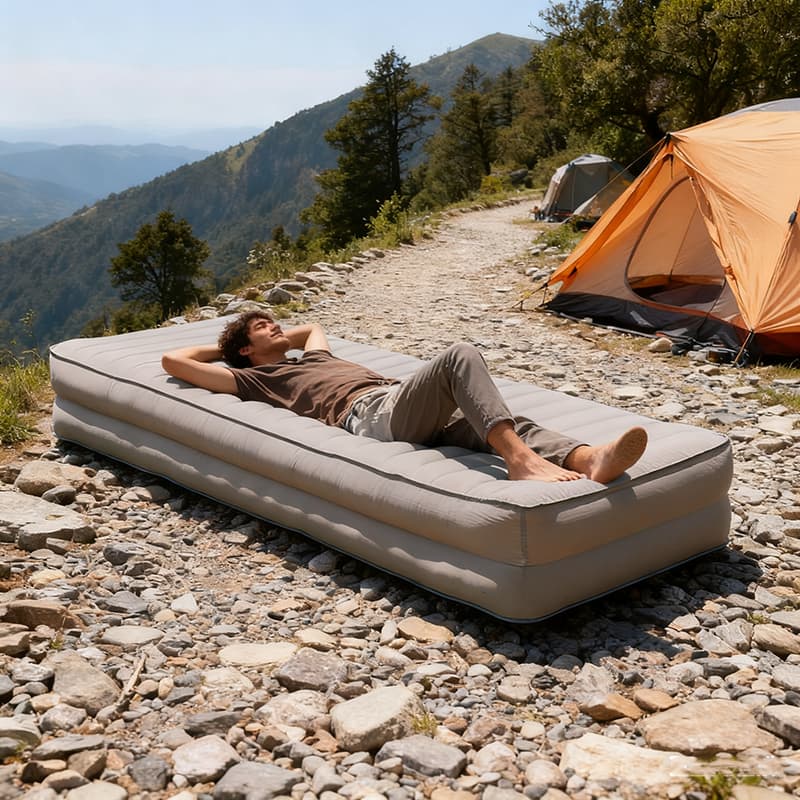
The Rise of “No-Compromise Comfort”: Even on Rough Terrain
Gone are the days when camping meant sleeping on rock-hard ground or avoiding uneven surfaces. 2025 campers want comfort that follows them anywhere—and Dreamate’s Outdoor Mattress delivers exactly that:
Durability Meets Softness: Unlike flimsy camping pads that puncture easily, Dreamate’s outdoor mattress is built for rugged use. Its wear-resistant and damage-resistant design means you can set it up directly on gravel, rocky paths, or grass—no extra ground cover needed—while still sinking into a supportive, cloud-like feel. Finally, comfort that doesn’t fear the great outdoors.
All-Scenario Versatility: This isn’t just a “camping mattress”—it’s a multi-use essential. Throw it in the trunk for a beach day, lay it out at a music festival, or use it as a portable seating area for backyard bonfires. High usability is its superpower: whether you’re car camping, backpacking (it’s lightweight enough for short hikes!), or just picnicking in the park, it turns any spot into a comfortable zone.
Fun playstyle – Splicing
Smart Design for “Effortless Adventure”: Modular Fun
2025 campers don’t just want comfort—they want flexibility. Dreamate’s outdoor mattress checks this box with a clever zipper design that transforms how you use it:
Zip-and-Mix Customization: Each mattress comes with built-in zippers, so you can connect multiple units together. Need extra space for a family of four? Zip two or three mattresses side-by-side to create a “camping king bed.” Hosting friends for a group trip? Arrange them in a circle for a cozy outdoor lounge area. It’s a simple feature that unlocks endless fun possibilities—perfect for campers who love to get creative.
Space-Saving Convenience: When you’re not using the connected setup, the mattress folds compactly into a carry bag—easy to store in your car or backpack. No more bulky gear that takes up half your trunk; comfort that’s lightweight and portable.
A home away from home, soft and comfortable
2025’s “Home Away From Home” Aesthetic: Comfort That Feels Familiar
This year, camping is as much about ambiance as it is about adventure—and Dreamate’s outdoor mattress elevates your campsite’s vibe without trying:
Cozy, Inviting Vibe: Its soft, premium fabric adds a touch of luxury to any outdoor space, whether you’re pairing it with a fleece blanket for cool nights or using it as a base for your morning coffee setup. It turns “camping” into “outdoor living”—exactly the aesthetic 2025 campers crave.
Low-Maintenance Luxury: No need to stress about spills or dirt. The mattress’s water-resistant surface wipes clean in seconds, and its durable material stands up to mud, sand, and even accidental food drops. Comfort that’s easy to keep looking (and feeling) like new.
Who’s Loving This Trend
The 2025 “comfort camping” movement is driven by two key groups—both of whom are obsessed with Dreamate’s outdoor mattress:
First-Time Campers: Millennials and Gen Z are flocking to camping as a low-cost travel alternative, but they refuse to give up modern comforts. Dreamate’s mattress makes camping feel approachable: no more struggling with uncomfortable pads, just instant coziness that eases them into the hobby.
Family & Group Campers: With remote work making longer trips possible, families and friend groups are planning extended camping vacations. The modular design lets them create a space that fits everyone—whether it’s a family bed for kids and parents or a lounge area for game nights. It’s comfort that brings people together.
How to Embrace 2025’s Comfort Trend
Ready to upgrade your camping setup this year? Here’s how to make Dreamate’s Outdoor Mattress the center of your adventure:
Solo Trips: Pack a single mattress for lightweight comfort—perfect for backpacking or solo car camping. Set it up under the stars for a peaceful night’s sleep, no matter the terrain.
Family Getaways: Zip 2-3 mattresses together to create a family-sized sleeping area. Add a few throw pillows, and you’ve got a campsite bedroom that feels just like home.
Group Gatherings: Arrange 4+ mattresses in a circle for a communal lounge space. It’s ideal for storytelling, stargazing, or just hanging out with friends—comfort that’s meant to be shared.
Final Thought
2025’s camping trend proves that adventure and comfort don’t have to be opposites. With products like Dreamate’s Outdoor Mattress, you can have it all: the thrill of exploring the outdoors, the coziness of a soft bed, and the flexibility to adapt to any scenario. This year, don’t just go camping—go camping comfortably.
Have you tried using an outdoor mattress for your adventures? Or are you ready to unlock new camping fun with Dreamate’s modular design? To learn more about related content, you may visit our official website and get in touch with the relevant personnel.
- How it works: Lay 2 single mattresses side by side, line up the zippers along their edges, and pull—they’ll lock together tightly, no gaps or slipping. Add a third mattress at the foot, and you’ve got a “king-size” setup that fits 2 adults + 2 kids (or 4 teens).
- Why it’s better: No more waking up to a kid rolling into the gap between separate mattresses. The zippered connection keeps the surface smooth, so everyone sleeps through the night. Plus, if you’re camping solo later, just unzip and use one mattress—no need to haul a huge bed alone.
- How to use: Grab 2-3 mattresses (they’re lightweight enough to carry in a tote bag!), zip them into a rectangle or square, and lay them on the grass. The waterproof bottom keeps you dry (even if the grass is dewy), and the soft top lets you sit, lean, or even lie down.
- Pro tip: Bring a few throw pillows, and you’ve got a “park living room” for friends—no more fighting over space. After the picnic, unzip them, fold each up, and toss them back in your bag.
- Game-changer for families: If you’re driving 6+ hours, stop at a rest area, zip the durable air mattresses, and let your kids stretch out for a real nap—no more cranky, tired little ones. The comfortable air mattress is thick enough to cushion against the car’s hard seats, and the zippered connection stays put even if the car shifts.
- Bonus: When you reach your destination, unzip them and use one for camping—no need to pack extra gear.
- Setup in 5 minutes: Lay the mattresses on your patio or lawn, zip them into a long line, and add a blanket on top. The soft surface lets people lean against each other, stretch their legs, or even curl up—way more comfortable than stiff chairs.
- Kid-friendly: Kids can crawl around, sit, or lie down without falling off hard seats. After the movie, just unzip and store the mattresses—no bulky furniture to haul.
- Why it beats beach towels: Towels shift, get sandy, and don’t cushion you from hard sand. Our Outdoor Sleeping Pad stays put (the bottom grips the sand), keeps you soft and dry, and gives you enough space to lay out a book, snacks, and sunscreen.
- Post-beach hack: Shake off the sand (it wipes right off!), unzip, and fold—no sand in your car or bag.
- Guest room win: If you don’t have a guest room, zip 2 queen air mattresses together and lay them on the floor—your guests will thank you for the soft, supportive sleep (no more waking up with a sore back from a cheap air mattress).
- Lounge mode: Use one temporary bed as a floor cushion for movie nights, gaming, or reading—when you’re done, fold it up and store it in a closet.
- No gaps, no slipping: The heavy-duty zippers lock mattresses together tightly, so you never have to worry about them coming apart mid-use.
- Lightweight & easy to carry: Each mattress folds down to the size of a backpack, so you can take 2-3 with you without feeling weighed down.
- Durable for all seasons: Made with water-resistant, puncture-proof fabric, it works in rain, sun, sand, or grass—no need to baby it.
1. The "Invisible Pain Points" of Outdoor Camping – Have You Felt Them?
2. Three Core Advantages for a Refreshing Outdoor Experience
1. Easy to Clean: Wipe Away Stains in Seconds, Perfect for Lazy Users
2. Durable & Tough: Fearless Against Outdoor "Rough Terrain"
3. Stain-Resistant: Keep a Fresh Look, No More "Wearing Out Fast"
3. Bonus Details That Make a Difference
4. Who Is the Dreamate Mattress For?
5. Conclusion: Choose the Right Outdoor Mattress for Burden-Free Trips

Master the Lighting: Sync with Your Circadian Rhythm (Together)
Light is the #1 cue for your body’s sleep clock—so aligning your bedroom lighting helps both of you wind down faster.
- Ditch blue light 1-2 hours pre-bed: Swap late-night phone scrolling for a shared activity (like reading or chatting) under warm, dimmable bedside lamps (2700K-3000K bulbs). If one of you needs to work, use a blue light filter to avoid disrupting your partner’s melatonin.
- Block morning light (without arguments): Install blackout curtains to keep early sun out—no more one person reaching for a sleep mask while the other squints. For travel or odd schedules, a lightweight mask works for anyone who needs extra darkness.
Optimize Temperature: Cool Down for Deep Sleep (No More Blanket Tugs)
Your body drops in temperature to sleep, but couples often clash over “too hot” vs. “too cold.”
- Stick to 60-67°F (15-19°C): This sweet spot works for most people—adjust the thermostat once instead of arguing over layers. Add breathable cotton or linen sheets (they wick moisture) so neither of you overheats.
- A hack for feet lovers: If one of you is always cold, keep a small heated blanket (not too bulky!) on their side; the other can use a lightweight throw. No more stealing covers mid-night.
Banish Clutter: Calm Your Minds (and Your Space)
A messy bedroom spikes stress hormones—for couples, shared clutter (think: their gym bag on your side, your books on their nightstand) adds extra tension.
- Do a “couple’s purge”: Remove non-sleep items together: work laptops, laundry baskets, even that extra chair no one uses. Keep only essentials: bed, two nightstands, one lamp (or two, if you prefer separate lighting).
- Use hidden storage for shared items: Under-bed drawers for extra linens, nightstands with closed compartments for chargers—out of sight means no more “who left this here?” arguments.
The Big Win for Couples: Solve Mattress Hardness Wars
Here’s the truth: 70% of couples disagree on mattress softness, and a bad mattress ruins even the best-lit, coolest room. That’s why Dreamate Mattress was designed to fix this exact problem—so both of you get the support you need, without compromise.
What Makes Dreamate Perfect for Couples?
- Left-Right Zone Adjustment: Finally—no more “your side vs. my side” complaints. The mattress has separate firmness controls for each side: you can set your side to plush (great for side sleepers) while your partner chooses firm (ideal for back or stomach sleepers). Just use the wireless remote to tweak it anytime—no tools, no hassle.
- Washable, Hygienic Design: Let’s be real—shared beds get messy: coffee spills, pet hair, late-night snack crumbs. Dreamate’s cover zips off completely, and the entire mattress (yes, entire) is machine-washable. Toss it in cold water, tumble dry low, and it’s fresh again—no more hiding stains or worrying about dust mites.
- No Motion Transfer (Bonus!): Even if your partner tosses and turns all night, you won’t feel a thing. The mattress’s supportive layers absorb movement, so their restlessness doesn’t wake you up. It’s like sleeping on your own bed—without the distance.
Add Small, Shared Calming Touches
Make your space feel like yours together—small sensory details go a long way.
- A shared scent: Diffuse lavender or chamomile (both calm anxiety) on your nightstand. It’s a subtle way to sync your wind-down routines.
- One plant, two people: A small snake plant (easy to care for!) on the dresser purifies air and adds nature—no arguments over “who forgot to water it” (it only needs water every 2-3 weeks).
- Neutral colors, personal accents: Paint walls soft gray or beige (calming for everyone), then add small touches you love: their favorite throw pillow on their side, your favorite blanket on yours.
Conclusion
Sleep Better Together (Starting Tonight) Improving your sleep environment isn’t about overhauling your bedroom—it’s about fixing the small, annoying things that disrupt both of your sleep. And for couples, the biggest fix is a mattress that works for both of you.
Dreamate Mattress takes the “mattress war” off the table, so you can focus on what matters: waking up next to someone who’s just as rested as you are. Pair it with dimmable lights, a cool room, and a clutter-free space, and you’ll have a sleep environment that feels like a retreat—for two.
Ready to stop arguing about the mattress and start sleeping better? Head to Dreamate’s website to try a 100-night risk-free trial. And tell us: what’s your biggest sleep pet peeve with your partner? Let us know in the comments!
